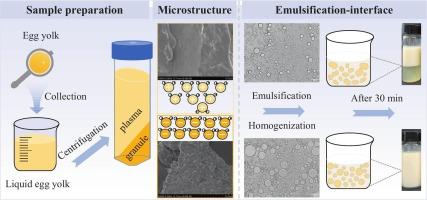蛋黄中关键组分热诱导乳状液不稳定的机理:甜菜碱介导的热聚集抑制
IF 9.8
1区 农林科学
Q1 CHEMISTRY, APPLIED
引用次数: 0
摘要
本研究旨在探讨甜菜碱和EY组分对其热稳定性和乳化性能的影响及其机理。流变学结果表明,颗粒的热聚集温度比等离子体高41.22 °C,甜菜碱使等离子体和颗粒的热聚集温度分别提高10.18 °C和11.88 °C。ζ电位测量表明,等离子体和颗粒之间存在固有的静电相互作用,颗粒中的电荷更强。血浆表现出优异的溶解性和乳化活性,而颗粒主要保持乳化稳定性。甜菜碱增强氢键相互作用,稳定蛋白质结构。SDS-PAGE分析提示,热诱导的EY组分失稳可能与血浆中的γ-活素或载脂蛋白有关。总之,甜菜碱有效地延缓了关键EY组分(等离子体)的热诱导聚集,维持了界面的稳定性。该研究促进了对EY分数级热聚集行为的理解,并为调节热聚集和扩展食品应用中的乳化性能提供了新的见解本文章由计算机程序翻译,如有差异,请以英文原文为准。

Mechanistic insights into heat-induced emulsion destabilization of key fractions in egg yolk: Betaine-mediated suppression of thermal aggregation
This study aims to investigate the effects and mechanisms of EY fractions and betaine on thermal stability and emulsifying property. Rheological results illustrated that granules exhibited a 41.22 °C higher thermal aggregation temperature than plasma, betaine raised the thermal aggregation temperatures of plasma and granules by 10.18 °C and 11.88 °C, respectively. ζ-potential measurements demonstrated inherent electrostatic interactions between plasma and granules, and the charge in granules was stronger. Plasma displayed excellent solubility and emulsifying activity, whereas granules predominantly maintained emulsifying stability. Betaine enhanced hydrogen bond interactions, stabilizing protein structures. SDS-PAGE analysis suggested that thermal-induced destabilization of EY fractions might involve γ-livetin or apo-LDL in plasma. In conclusion, betaine effectively retarded heat-induced aggregation of key EY fractions (plasma) and sustain interfacial stability. This study advances understanding of thermal aggregation behavior at the EY fraction level, and provides new insights into modulating thermal aggregation and extending emulsifying properties in food applications
求助全文
通过发布文献求助,成功后即可免费获取论文全文。
去求助
来源期刊

Food Chemistry
工程技术-食品科技
CiteScore
16.30
自引率
10.20%
发文量
3130
审稿时长
122 days
期刊介绍:
Food Chemistry publishes original research papers dealing with the advancement of the chemistry and biochemistry of foods or the analytical methods/ approach used. All papers should focus on the novelty of the research carried out.
 求助内容:
求助内容: 应助结果提醒方式:
应助结果提醒方式:


